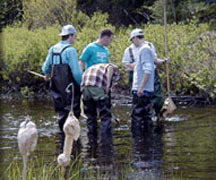
The University of Notre Dame Environmental Research Centers UNDERC- East, along with its neighboring collaborator Trout Lake Biological Station (University of Wisconsin-Madison), has been selected as a candidate core site for the National Ecological Observatory Network (NEON), a planned continental-scale ecological research platform.
UNDERC-East is approximately 8,000 acres owned by Notre Dame that straddles the border between Michigans Upper Peninsula and Wisconsin (also known as the Land OLakes property) that has been closed to the public for nearly a century and surrounded by hundreds of thousands of acres of public conservation lands. The UNDERC property furthers research and education in environmental studies by focusing activities on unique locations of high environmental quality in the North Central region of the U.S. The location serves as anaturallaboratory for the study of environmental systems that have experienced little of no degradation from humans and as a baseline for comparison with human disturbed systems. Trout Lake Biological Station, located within 20 miles of UNDEC-East, does not provide additional lands, but adds unique facilities, programs and research scientists.
NEON is a continental-scale research platform for discovering and understanding the impacts of climate change, land-use change, and invasive species on ecology. The National Science Foundation has funded the NEON design effort since September, 2004. The Observatory is expected to gather ecological data for more than 30 years.
UNDERC-East is one of 20 candidate core sites chosen for NEON. The sites were chosen because they best represent the ecoclimatic characteristics of their respective regions, or domains. Sixteen of the candidate sites are located in the continental United States, while Alaska hosts two and Hawaii and Puerto Rico one each.
Candidate core sites were selected through an analysis of more than 80 proposed locations (including three for the UNDERC-East region) submitted by the ecological research community in response to a NEON Request for Information.
Being selected as a candidate core site to represent the Great Lakes domain is a great honor for Notre Dame and indicates UNDERC-Easts unique environmental and infrastructure qualities,said UNDERC director Gary Belovsky,This also indicates the Universitys growing leadership in environmental sciences.
Each NEON domain will host a fully instrumented core site, as well as a variety of relocatable and mobile instrument systems.All of the measurements will be standardized and focused on a suite of questions related to invasive species, infectious diseases, biodiversity, biogeochemistry, climate change, land-use change, and ecohydrology at the continental scale—in regions as varied as Alaska, the Desert Southwest, the Great Lakes and New England.
NEON officials stress that the network is a true national network, not a collection of regional observatories. A network of sensors and advanced NEON cyberinfrastructure will record and archive long-term ecological data for use by researchers, students and teachers, citizen scientists, and decisionmakers.
Each candidate site is designed to act as a detector in a national observatory, sensing a portion of the domain, much as a single detector in a digital camera detects information from a portion of the scene being photographed, while the whole megapixel array creates an image,said NEON principal investigator David Schimel.
Researchers are already looking forward to the new views of ecology that will be created by continental-scale NEON data. Just as meteorologists today can predict the path of a tornado or hurricane, ecologists using NEON data in the future may be able to forecast the spread of avian flu and the West Nile virus, or the emergence of an invasive species.
Being part of the NEON network will attract leading national and international ecologists to conduct research at Notre Dame,Belovksy said.NEON infrastructure will provide unique educational and research opportunities for students and faculty from throughout the Great Lakes domain, as well as Notre Dame. NEON activities at UNDERC-East will commence this summer with a planning visit by NEON scientists.
In addition to UNDERC-East, Notre Dame in recent years has added UNDERC-West and UNDERC-South. UNDERC-West encompasses more than a million acres in western and central Montana surrounded by the Rocky Mountains. Much of the land is administered by the Confederated Salish and Kootenai Tribes, who are partners with the University in this environmental education and research program that involves Native American students and culture. UNDERC-South is a joint program with the University of Puerto Rico for education and research in the Puerto Rican rainforest.
More information about UNDERC can be found at https://underc.nd.edu .For NEON news, visit www.neoninc.org .
_ Contact: Gary Belovsky, Martin J .Gillen Director of UNDERC and professor of biological sciences, 906-842-UNDE,_ " belovsky.1@nd.edu ":mailto:belovsky.1@nd.edu
TopicID: 28006